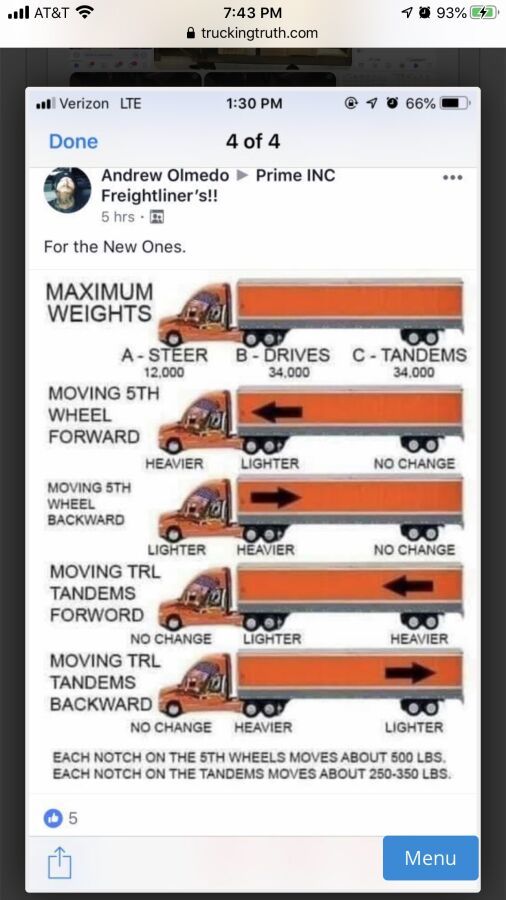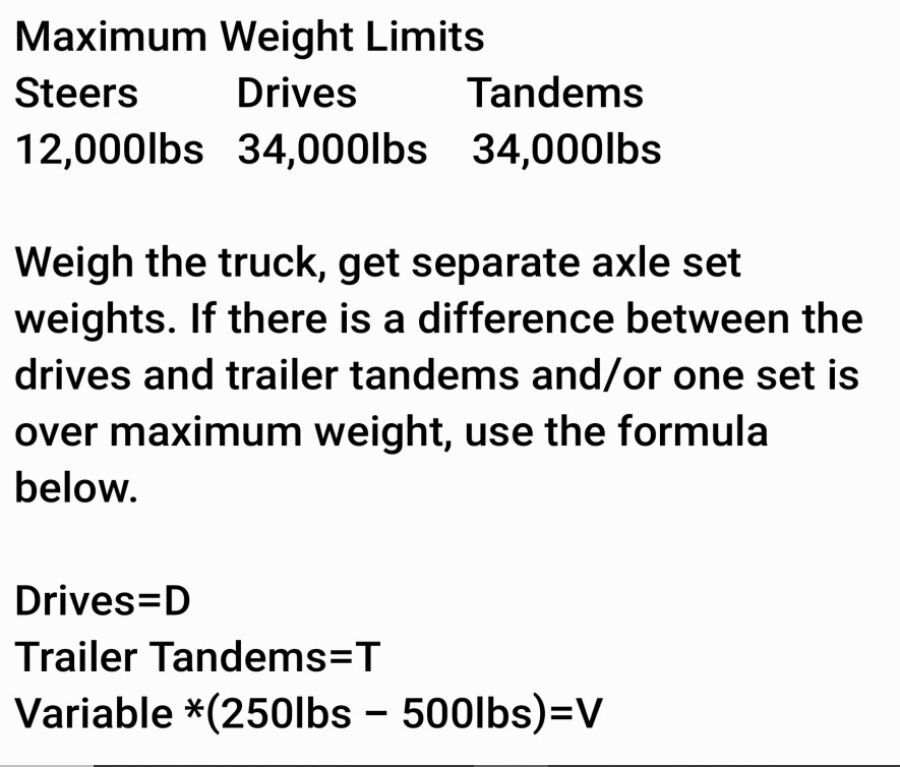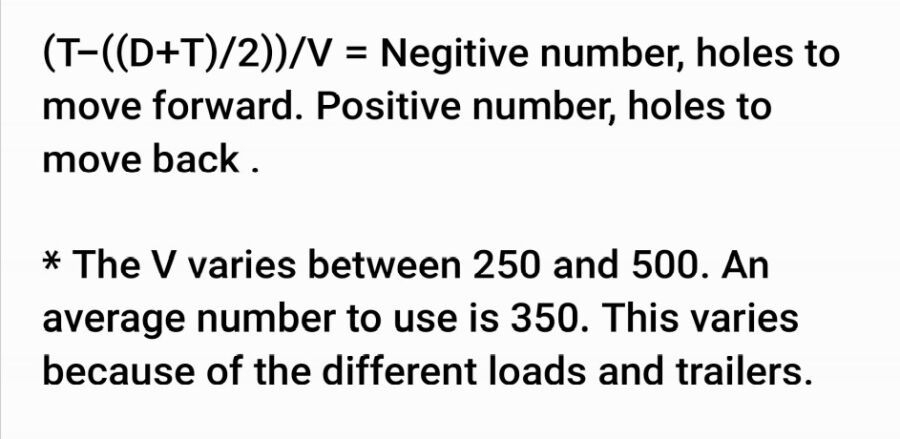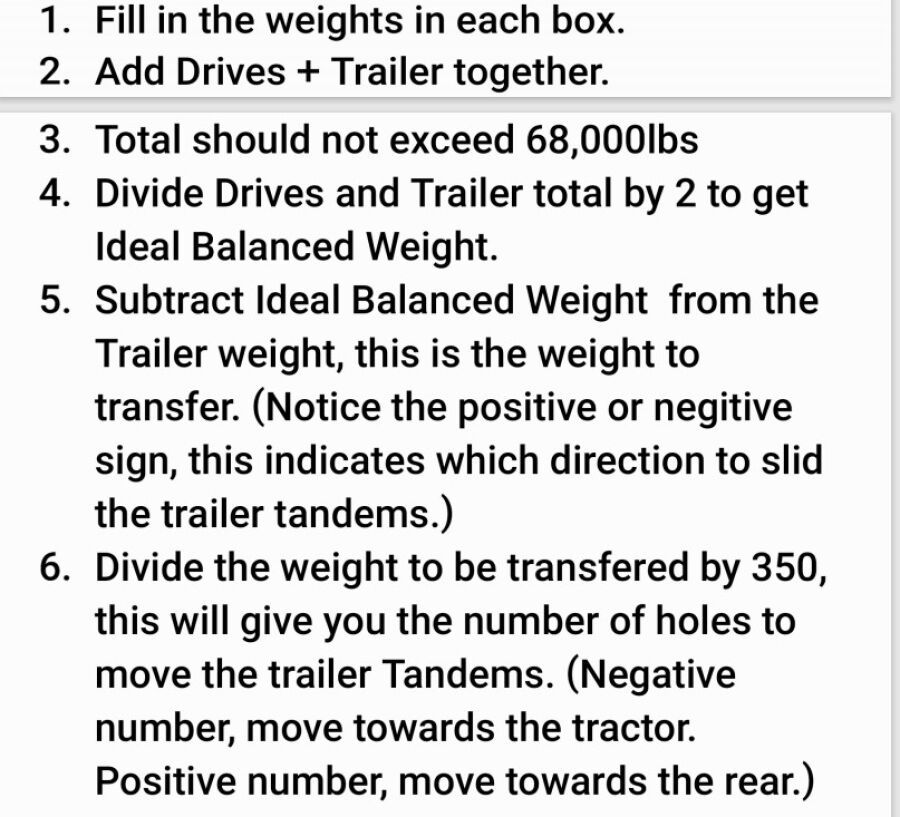Weighing At Scale And Sliding Tandems
Topic 30392 | Page 1
I'm not going to deal with the 5th wheel, tho that's light. I have my steers set to weigh 11,600+/- a little.
1. When the drives are overweight, push the trailer back so the tandems are more to the front of the rail.
2. When the tandems/trailers are heavy, pull the trailer forward so the tandems are more toward the back of the trailer.
Laura
Tandems:
Tandem Axles
A set of axles spaced close together, legally defined as more than 40 and less than 96 inches apart by the USDOT. Drivers tend to refer to the tandem axles on their trailer as just "tandems". You might hear a driver say, "I'm 400 pounds overweight on my tandems", referring to his trailer tandems, not his tractor tandems. Tractor tandems are generally just referred to as "drives" which is short for "drive axles".
Tandem:
Tandem Axles
A set of axles spaced close together, legally defined as more than 40 and less than 96 inches apart by the USDOT. Drivers tend to refer to the tandem axles on their trailer as just "tandems". You might hear a driver say, "I'm 400 pounds overweight on my tandems", referring to his trailer tandems, not his tractor tandems. Tractor tandems are generally just referred to as "drives" which is short for "drive axles".
Just to add on... For either scenario, assuming you're tandems are slid all the way forward, you would want to slide you tandems back or forward (each hole transfers approx. 500 lbs in each direction)
Tandems:
Tandem Axles
A set of axles spaced close together, legally defined as more than 40 and less than 96 inches apart by the USDOT. Drivers tend to refer to the tandem axles on their trailer as just "tandems". You might hear a driver say, "I'm 400 pounds overweight on my tandems", referring to his trailer tandems, not his tractor tandems. Tractor tandems are generally just referred to as "drives" which is short for "drive axles".
Tandem:
Tandem Axles
A set of axles spaced close together, legally defined as more than 40 and less than 96 inches apart by the USDOT. Drivers tend to refer to the tandem axles on their trailer as just "tandems". You might hear a driver say, "I'm 400 pounds overweight on my tandems", referring to his trailer tandems, not his tractor tandems. Tractor tandems are generally just referred to as "drives" which is short for "drive axles".

Thanks for the reply IDMtnGAL and DoctorWho_214
Dm:
Dispatcher, Fleet Manager, Driver Manager
The primary person a driver communicates with at his/her company. A dispatcher can play many roles, depending on the company's structure. Dispatchers may assign freight, file requests for home time, relay messages between the driver and management, inform customer service of any delays, change appointment times, and report information to the load planners.Sorry, picture didnt load last post

A little story to help you figure which way to move the tandems:
If the drive wheels are too heavy, the tandems say "I'll move in and help you."
If the tandems are to heavy, they say "this is too much weight. I'm outta here."
It sounds dorky, but if it helps you to figure your balance, use it.
Tandems:
Tandem Axles
A set of axles spaced close together, legally defined as more than 40 and less than 96 inches apart by the USDOT. Drivers tend to refer to the tandem axles on their trailer as just "tandems". You might hear a driver say, "I'm 400 pounds overweight on my tandems", referring to his trailer tandems, not his tractor tandems. Tractor tandems are generally just referred to as "drives" which is short for "drive axles".
Tandem:
Tandem Axles
A set of axles spaced close together, legally defined as more than 40 and less than 96 inches apart by the USDOT. Drivers tend to refer to the tandem axles on their trailer as just "tandems". You might hear a driver say, "I'm 400 pounds overweight on my tandems", referring to his trailer tandems, not his tractor tandems. Tractor tandems are generally just referred to as "drives" which is short for "drive axles".
I have my 5th wheel set so my steers are a bit heavier too. Below is a formula for figuring out sliding your tandems. It works really well, but it took me a while to figure it out. A lot of times I just do with quick math, by subtracting the drives from the tandems or visa versa, cutting it half then divide by 350. But the formula is a lot more precise.



Tandems:
Tandem Axles
A set of axles spaced close together, legally defined as more than 40 and less than 96 inches apart by the USDOT. Drivers tend to refer to the tandem axles on their trailer as just "tandems". You might hear a driver say, "I'm 400 pounds overweight on my tandems", referring to his trailer tandems, not his tractor tandems. Tractor tandems are generally just referred to as "drives" which is short for "drive axles".
Tandem:
Tandem Axles
A set of axles spaced close together, legally defined as more than 40 and less than 96 inches apart by the USDOT. Drivers tend to refer to the tandem axles on their trailer as just "tandems". You might hear a driver say, "I'm 400 pounds overweight on my tandems", referring to his trailer tandems, not his tractor tandems. Tractor tandems are generally just referred to as "drives" which is short for "drive axles".
Someone posted previously that the Truckers Slide Calc app was simple to use and helpful for them.
Slide the tandems to the problem. Trailer tandems to heavy slide back. Drives to heavy slide forward. Our trailer holes equal about 250 lbs each.
Don't have a sliding fifth wheel, so I don't know anything about that except it affects length laws in WV.
Tandems:
Tandem Axles
A set of axles spaced close together, legally defined as more than 40 and less than 96 inches apart by the USDOT. Drivers tend to refer to the tandem axles on their trailer as just "tandems". You might hear a driver say, "I'm 400 pounds overweight on my tandems", referring to his trailer tandems, not his tractor tandems. Tractor tandems are generally just referred to as "drives" which is short for "drive axles".
Tandem:
Tandem Axles
A set of axles spaced close together, legally defined as more than 40 and less than 96 inches apart by the USDOT. Drivers tend to refer to the tandem axles on their trailer as just "tandems". You might hear a driver say, "I'm 400 pounds overweight on my tandems", referring to his trailer tandems, not his tractor tandems. Tractor tandems are generally just referred to as "drives" which is short for "drive axles".
KNOW YOUR EQUIPMENT....on every trailer I've used over the course of 2.5 years each hole transfers 250 pounds per hole. If the holes are spaced 4 inches its 250 per hole and 400 pounds per hole if it has 6 in spacing. I've yet to have a trailer with 6 inch spacing. So yes, there are different trailers, the most common are 4 inch spacing which is 250 pounds per hole. However it is my understanding that sliding the 5th wheel is appropriately 500 pounds per hole.
Just to add on... For either scenario, assuming you're tandems are slid all the way forward, you would want to slide you tandems back or forward (each hole transfers approx. 500 lbs in each direction)
Tandems:
Tandem Axles
A set of axles spaced close together, legally defined as more than 40 and less than 96 inches apart by the USDOT. Drivers tend to refer to the tandem axles on their trailer as just "tandems". You might hear a driver say, "I'm 400 pounds overweight on my tandems", referring to his trailer tandems, not his tractor tandems. Tractor tandems are generally just referred to as "drives" which is short for "drive axles".
Tandem:
Tandem Axles
A set of axles spaced close together, legally defined as more than 40 and less than 96 inches apart by the USDOT. Drivers tend to refer to the tandem axles on their trailer as just "tandems". You might hear a driver say, "I'm 400 pounds overweight on my tandems", referring to his trailer tandems, not his tractor tandems. Tractor tandems are generally just referred to as "drives" which is short for "drive axles".
New Reply:
New! Check out our help videos for a better understanding of our forum features

















Preview:
This topic has the following tags:
Advice For New Truck Drivers Becoming A Truck Driver Cameras Photos Truck Driver Safety







 TT On Facebook
TT On Facebook
Hello fellow drivers. I would like a little help if you don't mind. I need a little lesson if you will on sliding the tandems at the scales so that I am not over weight on steers, drives, or truck/trailer. Here is my dilema below I have 2 scenerios: 1. I weighed in at Steer 10660, Drives 45560, Truck 72360. Which comes out to Steer 10660, Drives 34900, Truck 26800. I know I am over on the Drives 900lbs. My question which way should I slide my tandem forward (toward the tractor) or back (toward rear of trailer)?
2. I weighed in at Steer 10500, Drives 43200, Truck 78700. Which comes out to Steer 10500, Drives 32700, Truck 35500. I know I am over on the Truck 1500lbs. My question which way should I slide my tandems forward (toward the tractor) or back (toward rear of trailer)?
If it matters I have my 5th wheel sitting about middle ways to where the pin sits over the rear tandems on the tractor. Thanks for your help in advance.
Tandems:
Tandem Axles
A set of axles spaced close together, legally defined as more than 40 and less than 96 inches apart by the USDOT. Drivers tend to refer to the tandem axles on their trailer as just "tandems". You might hear a driver say, "I'm 400 pounds overweight on my tandems", referring to his trailer tandems, not his tractor tandems. Tractor tandems are generally just referred to as "drives" which is short for "drive axles".
Tandem:
Tandem Axles
A set of axles spaced close together, legally defined as more than 40 and less than 96 inches apart by the USDOT. Drivers tend to refer to the tandem axles on their trailer as just "tandems". You might hear a driver say, "I'm 400 pounds overweight on my tandems", referring to his trailer tandems, not his tractor tandems. Tractor tandems are generally just referred to as "drives" which is short for "drive axles".